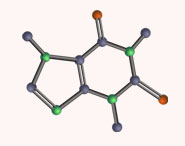


 علم الكيمياء
علم الكيمياء 
 الكيمياء التحليلية
الكيمياء التحليلية 
 الكيمياء الحياتية
الكيمياء الحياتية 
 الكيمياء العضوية
الكيمياء العضوية 
 الكيمياء الفيزيائية
الكيمياء الفيزيائية
 الكيمياء اللاعضوية
الكيمياء اللاعضوية 
 مواضيع اخرى في الكيمياء
مواضيع اخرى في الكيمياء
 الكيمياء الصناعية
الكيمياء الصناعية |
أقرأ أيضاً
التاريخ: 2024-06-01
التاريخ: 12-9-2019
التاريخ: 23-1-2020
التاريخ: 30-3-2017
|
Having introduced you to the sequence of events that makes up a nucleophilic attack at C=O (interaction of HOMO with LUMO, formation of new σ bond, breakage of π bond), we should now tell you a little more about the direction from which the nucleophile approaches the carbonyl group. Not only do nucleophiles always attack carbonyl groups at carbon, but they also always approach from a particular angle. You may at fi rst be surprised by this angle, since nucleophiles attack not from a direction perpendicular to the plane of the carbonyl group but at about 107° to the C=O bond—close to the angle at which the new bond will form. This approach route is known as the Burgi–Dunitz trajectory after the authors of the elegant crys tallographic methods that revealed it. You can think of the angle of attack as the result of a compromise between maximum orbital overlap of the HOMO with π* and minimum repulsion of the HOMO by the electron density in the carbonyl π bond. But a better explanation is that π* does not have parallel atomic orbitals as there is a node halfway down the bond (Chapter 4) so the atomic orbitals are already at an angle. The nucleophile attacks along the axis of the larger orbital in the HOMO.
Any other portions of the molecule that get in the way of (or, in other words, that cause steric hindrance to) the Burgi–Dunitz trajectory will greatly reduce the rate of addition and this is another reason why aldehydes are more reactive than ketones. The importance of the Burgi Dunitz trajectory will become more evident later, particularly in Chapter 33.



|
|
|
|
حقن الذهب في العين.. تقنية جديدة للحفاظ على البصر ؟!
|
|
|
|
|
|
|
علي بابا تطلق نماذج "Qwen" الجديدة في أحدث اختراق صيني لمجال الذكاء الاصطناعي مفتوح المصدر
|
|
|
|
|
|
|
بالفيديو: نقيب المهندسين العراقيين خلال جولته في مشاريع العتبة الحسينية برفقة رئيس قسم الإعلام: مشهد مفرح يظهر اهتماما كبيرا بالجانبين الإنساني والصحي
|
|
|